By: Elizabeth Riley
Back to school season can be overwhelming while acclimating to new routines and projects. As the weather begins to cool and our lives become packed with responsibilities, it is important to take time outside, surrounding ourselves with all the people, places, and events that Waco has to offer. The start of the semester also brought around 3,000 freshman University students to Waco. The greatest way to get comfortable with the city would be to get involved in the community in many ways.
Homework
Saturday, September 7, 2024: Waco History Scavenger Hunt

The Waco History Scavenger Hunt is a self-paced, online based activity, in which participants travel to historic locations across Waco, take pictures to post on social media, and enter the chance to win prizes. This activity can be started anytime from 8:30 am to 11:00 am by following instructions on the Waco History App.
Sunday, September 8, 2024: Church Hopping
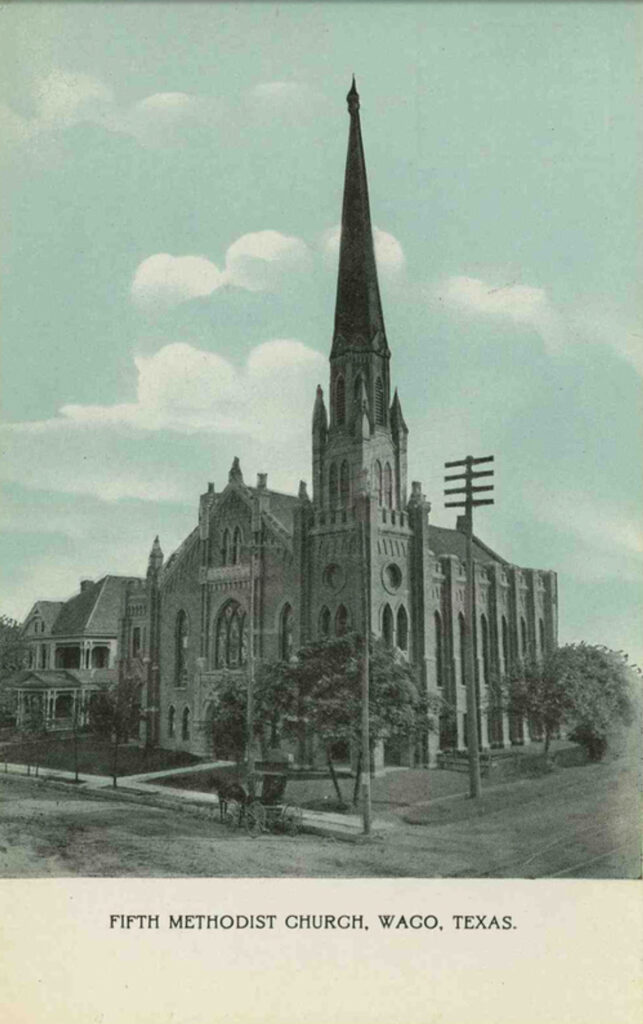
There are almost 200 different churches in the greater Waco area. The start of a new semester is the perfect time to travel between establishments, finding a spiritual home that fits your needs. After sampling denominational communities and pastors, taste test breakfast and brunch restaurants around town, such as Harvest on 25th, Our Breakfast Place on Franklin, or The Toasted Yolk on Washington.
https://spirituallife.web.baylor.edu/campus-ministries-church-connections/local-churches
Monday, September 9, 2024: Genealogy Research Walkthrough
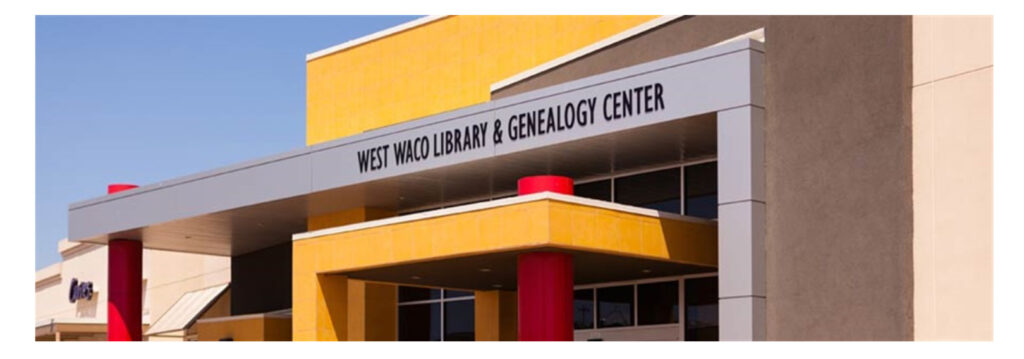
Does your family have deep ties to Texas or the Southeast? The West Waco Library and Genealogy Center is helping uncover and rediscover family histories from 12:00 pm to 1:15 pm on Monday. After searching through records of cemeteries, newspapers, and other archival sources, use the library space to get ahead with academic responsibilities. Study time is vital!
https://calendar.wacolibrary.org/event/11526027
Tuesday, September 10, 2024: Baylor Women’s Volleyball vs SMU

Baylor Women’s Volleyball takes on the ACC’s Southern Methodist University at the Ferrell Center at 7 pm. The women’s volleyball team has won all four of their opening games, and they are hoping to extend this winning record against the Big Ten/Big 12 Challenge opponents. Volleyball sporting season lasts until November. If you’re unable to catch this week’s match, check out the schedule to find a game for you!
https://baylorbears.com/sports/womens-volleyball/schedule/2024
Thursday, September 11, 2024: Outdoor Adventure Club takes on Archery

The Outdoor Adventure Club is taking on archery for their welcome back activity! Designated for kids ages 6-11, this program will teach general safety for shooting arrows, care and maintenance for owning a bow, and history of the sporting event itself. Safely practice what you learn with the Outdoor Adventure Club from 4:30pm to 5:30pm on Thursday.
https://calendar.wacolibrary.org/event/12124212
Friday, September 12, 2024: Premier of Waco Civic Theater’s production of A Midsummer Night’s Dream by William Shakespeare

Love. Magic. Forests. Faries. From now until September 22nd, the Waco Civic Theater is performing the classic Shakespearean play, A Midsummer Night’s Dream. Tickets for the 7:30 pm show cost $22-$25, and they can be purchased online.
Baylor Family Weekend Begins

Friday kicks off Baylor’s Family Weekend, for which loved ones of current students are invited back to campus for festivities. This year’s activities include Taste of Waco food sampling, After Dark talent performances, and Vertical family worship. Baylor Football takes on Air Force at 6:30 pm on Saturday.
https://familyweekend.web.baylor.edu
Elizabeth Riley hails from Tennessee and is a senior studying English and Professional Writing & Rhetoric at Baylor University. She works as a Transcription Assistant at the Baylor University Institute for Oral History and is President of the Baylor Ice Girls for the 2024-2025 season.
by: Debrah Wright
As Waco prepares for its municipal elections, attention turns to the candidates and the diverse issues they aim to tackle. The mayoral race, in particular, has garnered interest, with candidates offering varied approaches to address the city’s challenges and opportunities.
**Mark Your Calendars: Election Details**
The general election for the City of Waco Mayor and Council Members for Districts I and III is scheduled for Saturday, May 4, 2024. Early voting will be open from April 22 through April 30, 2024, providing flexibility for residents to participate. Following the election, those elected will be sworn in at a Special Meeting on May 14, 2024, at 6 p.m.
**Accessible Voting Locations and Times:**
McLennan County has designated multiple early voting sites, including the Records Building, community centers, and libraries, ensuring accessibility for all residents. The early voting schedule offers extended hours, accommodating diverse schedules and commitments. Below are the early voting locations and times:
– McLennan County Records Building: 214 N 4th Street, Suite 300
– Robinson Community Center: 106 W. Lyndale Avenue
– Waco Multi-Purpose Community Center: 1020 Elm Avenue
– West Waco Library: 5301 Bosque Blvd
– Hewitt City Hall: 200 Patriot Court
Early voting times are as follows:
– Monday, April 22 to Friday, April 26: 8 a.m. to 5 p.m. each day
– Saturday, April 27: 7 a.m. to 7 p.m.
– Sunday, April 28: 1 to 6 p.m.
– Monday, April 29 to Tuesday, April 30: 7 a.m. to 7 p.m. each day
The mayoral race features three candidates:
Three candidates are vying to become the next mayor of Waco, to be decided in May. Jim Holmes, the District 5 council member and mayor pro tem; Aubrey Robertson, an attorney and former Democratic candidate for McLennan County district attorney; and Eric Brown, a pastor and activist, have each filed for the seat. The winner of the May 4 election will succeed Dillon Meek.
**Jim Holmes:** Jim Holmes has served on the Waco City Council since 2016. With 35 years of financial management experience, including roles as COO/EVP of FirstCity Financial Corp & SVP of FNB of Central Texas, he brings a wealth of expertise. Currently, he serves as President of HOTCOG, Chairman of Waco MPO, & Board Director for Waco Sports Commission & Cameron Park Zoo. Jim is a graduate of Creighton University and attended Baylor School of Law. Bringing a background in public service, Holmes emphasizes infrastructure investment and economic development as key priorities for Waco’s future. (https://www.jimholmeswaco.org/)
**Aubrey Robertson:** Aubrey Robertson is an attorney with a background in Political Science and Slavic and Eastern European Studies. Transitioning from aspiring to draft constitutions for former Soviet countries to focusing on the criminal justice system, he gained experience in mock trials and criminal law clinics. Aubrey’s extensive experience includes pro bono work, internships, and roles as both a prosecutor and defense attorney. Currently serving as the District Court Felony Chief at the Law Offices of Vic Feazell, P.C., he prioritizes keeping clients informed and confident throughout legal proceedings. With a focus on economic revitalization and community empowerment, Robertson aims to foster small business growth and expand access to affordable housing, known for his stance on Public safety. (https://www.aubreyforda.com/)
**Eric Brown:** Eric Brown brings a dedication to public service and community advocacy. With a background in business administration, he focuses on economic development, education, affordable housing, public safety, environmental sustainability, and social equity. Eric aims to create a brighter future for all residents through innovative solutions and active listening to community voices. Advocating for grassroots initiatives and sustainable development, Brown prioritizes environmental stewardship, social equity, and inclusive governance. (https://www.ericforwaco.com/)
In addition to the mayoral race, other important contests include:
– Waco Independent School District Board of Trustees At-Large, Place 6: Keith Guillory and Lauren Caldwell offer their visions for the future of education in Waco.
– McLennan Central Appraisal District Board Member, Place 2: David R. Schleicher and Perry Felton vie for this position, focusing on fair property assessments.
– McLennan Central Appraisal District Board Member, Place 3: William “Bill” W. Vernon, Jr., Linda Hatchel, and Dennis DeGraff compete for this seat, each with their own ideas for effective property valuation practices.
**Get Involved: Exercise Your Right to Vote**
As the election approaches, it’s crucial for Waco residents to educate themselves on the candidates and their platforms. Whether casting their ballots during early voting or on Election Day, every vote counts in shaping the future of the city. For more information on voting locations and ballots, residents can visit mclennan.gov/elections and make their voices heard in this pivotal election.
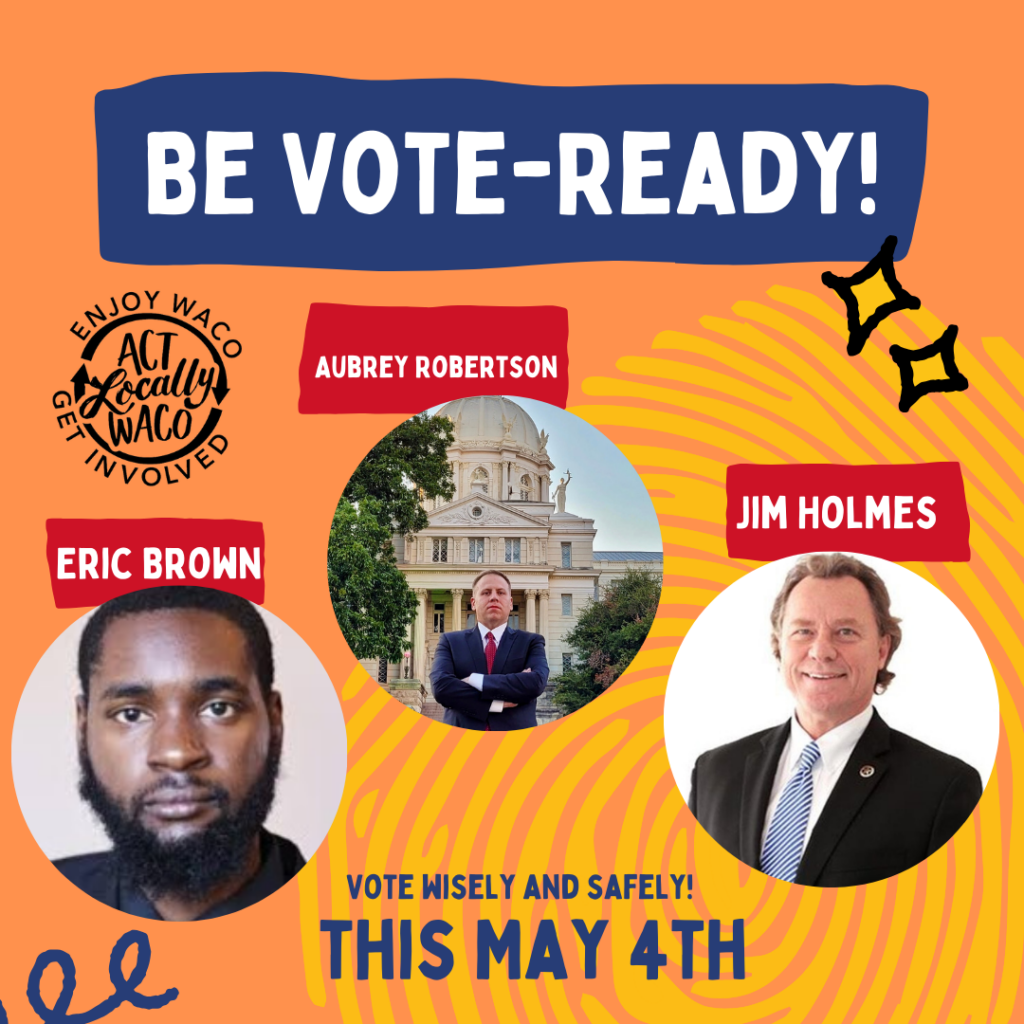
A Celebration of Heritage and Diversity
by: Debrah Wright
Black History Month serves as an annual tribute to the remarkable achievements of African Americans, highlighting their pivotal role in shaping the nation’s history. In Waco, Texas, we proudly participate in this celebration, fostering a sense of community and understanding through a diverse array of events throughout the month.
Originating from “Negro History Week,” conceived by historian Carter G. Woodson and other influential African Americans, Black History Month gained official recognition in 1976, with every U.S. president designating February as a time to honor the contributions of African Americans.
Waco’s rich history is deeply intertwined with the presence and influence of African Americans, dating back to the mid-nineteenth century when the first black residents, initially brought as slaves, played pivotal roles in the region’s development. Post-Civil War, they actively worked to rebuild their lives as freedmen and freedwomen, contributing significantly to the growth of Waco and McLennan County.
From the historic HBCU Paul Quinn College to the Farmers Improvement Society advocating for equal treatment post-Civil War, Waco’s Black history is filled with inspiring narratives. All Waco residents and visitors alike can celebrate Black History Month by exploring Black-owned businesses and participating in various events and learning opportunities throughout February.
Highlighted events include a Ceremonial Groundbreaking for the Memorial to Enslaved Persons hosted by Baylor University on February 23 at 1:30 P.M. and a Black History Walking Tour led by experts from Baylor University’s Institute for Oral History on Saturday, February 24th.
Join experts from Baylor University’s Institute for Oral History as they lead you through Downtown Waco for its third annual Black History Walk. Gain insights into historic locations during this educated tour, where guides will highlight influential Black figures like Waco’s first Black mayor, the initial Black female mayor, and the late Commissioner Patricia Miller.
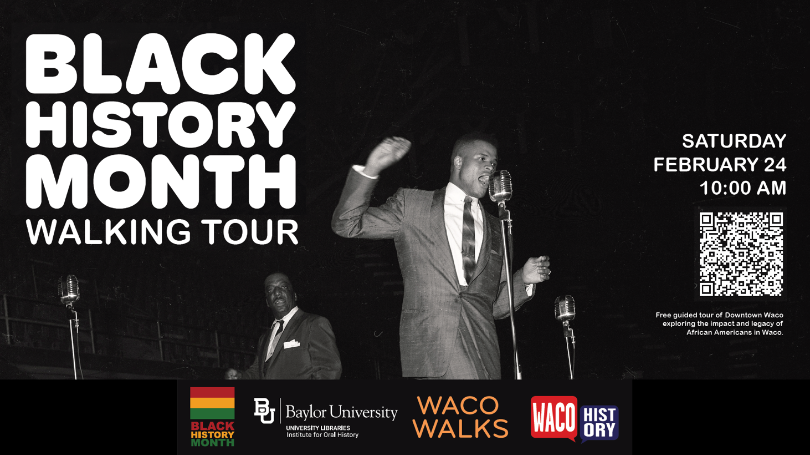
Notably, Waco’s Black history once thrived on Bridge Street, but after the 1953 tornado, business owners relocated to Elm Avenue. The walk commences at the McLennan County Courthouse in downtown on Saturday, February 24th, running from 10 a.m. to 12 p.m. Be part of this enriching journey uncovering the impactful stories woven into Waco’s historical tapestry.
Waco residents and visitors can also embark on a self-guided tour of Black history throughout the city, curated by Baylor’s Institute for Oral Histories and the Texas Collection. This tour, running from February 1 to 29, explores significant landmarks, churches, bridges, and businesses that contribute to Waco’s diverse heritage.
Additional events include “Black History in the Archives” on February 27th at 4 p.m., hosted by the Black Faculty & Staff Association and The Texas Collection at the Carroll Library, and an Afro-LatinX Cultural Heritage Celebration on February 28th, hosted by the Society for Advancement of Chicanos/Hispanics and Native Americans in Science at Baylor University in the Student Union Building at 5 p.m. There is also the Big XII Conference on Black Student Government, hosted by Iowa State University from February 29 to March 3, promises a series of engaging discussions and activities.
Explore the Mini Black History Museum at the Dewey Community Center before it closes on February 29th. The Dewey team has curated an excellent display, and the exhibit is available during the following hours:
Monday to Thursday: 9 a.m. to 9 p.m. (museum closed from 3 p.m. to 6 p.m.)
Friday: 9 a.m. to 3 p.m. (museum closed after 3 p.m.)
Saturday: 9 a.m. to 3 p.m.
Don’t miss the chance to immerse yourself in this enlightening experience celebrating Black history.
Furthermore, Creative Arts Experiences held throughout the month provide opportunities to delve into the works of influential Black authors, musicians, and theatrical performances.
Experience the enchanting melodies of America’s most original genre, jazz, with Baylor’s Concert Jazz Ensemble on February 29 at 7:30 p.m. in Jones Concert Hall, Glennis McCrary Music Building.
Join us in Waco as we commemorate Black History Month, embracing the past, present, and future of our diverse community.
Waco, TX (Nov. 23, 23)—In light of the challenges presented by increasing food costs, The Salvation Army of McLennan County is helping by offering Thanksgiving meals to anyone in need. “Rising food costs have created challenges for many people in our community,” said Major James Taylor, leader of The Salvation Army of McLennan County. “Anyone needing food this Thanksgiving is invited to get a hot Thanksgiving meal.”
Community Meal: The Salvation Army hosts a Thanksgiving meal at the Community Kitchen to share the season’s spirit. This will be the 132nd year to serve a Thanksgiving meal in Waco Texas.
Date: Thursday, November 23, 2023
Time: 11:00 a.m. – 2:00 p.m.
Location: 300 Webster Avenue, Waco TX, 76706
How to Get Help:
If you need a Thanksgiving meal, please join us at 300 Webster Avenue on Thursday, November 23, 2023 from 11:00 a.m. to 2:00 p.m.
Volunteer Opportunities:
We are looking for volunteers to support this event. To volunteer, please sign up online at The Salvation Army Waco/McLennan County – Volunteer Console (cervistech.com) or contact our Volunteer Coordinator at 254.756.7271. We are also asking for pies and cookies and cakes from the community for the event.
Donations:
Your support and generosity will help ensure that everyone in our community can enjoy a warm Thanksgiving meal during this season of gratitude. Donate by visiting our offices at 4721 W. Waco Drive or by mailing a check to 4721 W. Waco Drive, Waco, TX 76710. Please note “Thanksgiving Meals” on the check memo line. Thank you for your kindness and community spirit. Pies, cookies and cakes are need too!
For additional information, please contact 254.756.7271 M-F 8-5 or visit Facebook to see the event.
###
About The Salvation Army
The Salvation Army, an evangelical part of the universal Christian church established in London in 1865, has been supporting those in need in His name without discrimination for more than 130 years in the United States. Nearly 30 million Americans receive assistance from The Salvation Army each year through the broadest array of social services that range from providing food for the hungry, relief for disaster victims, assistance for the disabled, outreach to the elderly and ill, clothing and shelter to the homeless and opportunities for underprivileged children. 82 cents of every dollar The Salvation Army spends is used to support those services in 5,000 communities nationwide. For more information, go to www.salvationarmyusa.org
By Julia Kim, MCC Public Relations Intern
Being one of only 20 community colleges nominated across the country, McLennan Community College has been recognized, for the fifth time, as a shining example of inclusivity and excellence in education. Categorized as one of the 2023 Most Promising Places to Work in Community Colleges by the National Institute for Staff and Organizational Development (NISOD), MCC stands as a beacon of the Waco community.
This nomination reaffirms MCC’s dedication to providing an inclusive learning and working environment. The college’s commitment to diversity is reflected in its student and staff recruitment and retention practices, inclusive learning environments, meaningful community service and engagement opportunities. These practices ensure that students and faculty not only feel welcomed but valued.
“At MCC, teachers not only have a passion for our craft or field of study, but we work with a common denominator of the success of our students,” Mandy Morrison, Associate Professor of Music, said. “That commonality is the driving factor in all of our decisions.”
MCC’s impact extends far beyond the campus walls. It plays a vital role in the Waco community, offering education and opportunities that transform lives. MCC extends a helping hand to the community through its outreach efforts like the Highlanders for Community program. This program allows opportunities for students to volunteer and become more involved in the Waco area. The college also offers work-study opportunities for students so they can learn about different job environments.
“I have always experienced a friendly community at MCC as a student and employee,” second-year student, Alex Flores said. “Working at the college as a student has helped prepare me for the jobs I would like to have in the future.”
With this latest accolade, McLennan Community College reaffirms its status as an example of inclusivity, diversity and excellence, leaving a mark on the hearts and minds of students, staff and the Waco community.
McLennan Community College Hosts Annual Trunk or Treat Event
As the temperature cools and autumn leaves paint the campus, McLennan Community College is gearing up for an event that promises fun, laughter. and a sense of community. From 5-6:30 p.m. on Oct. 31, McLennan Athletics will host their “Trunk or Treat” event, bringing together students, faculty, and the Waco community for a safe and enjoyable Halloween celebration.
The event will be held in Parking Lot outside The Highlands gym, on the MCC campus. It will feature trunks decorated by MCC students, faculty and staff members, and numerous student groups. Local food trucks will also be on hand for those with an appetite for something other than candy.
“We are thrilled to host our annual Trunk or Treat,” Sports Information Specialist Candice Kelm said. “This event is a fantastic opportunity to embrace the Halloween spirit and foster a sense of togetherness among our diverse community.”
Attendees are encouraged to continue the fun at McLennan Madness beginning at 7 p.m. inside the gym. The pep-rally style event will include player introductions, special performances, fan costume contests, giveaways and more for attendees as MCC prepares for the start of basketball season Nov. 1.
Admission is free, and all are welcome to attend both events. For more information, email [email protected].
By: Hope Middlebrook
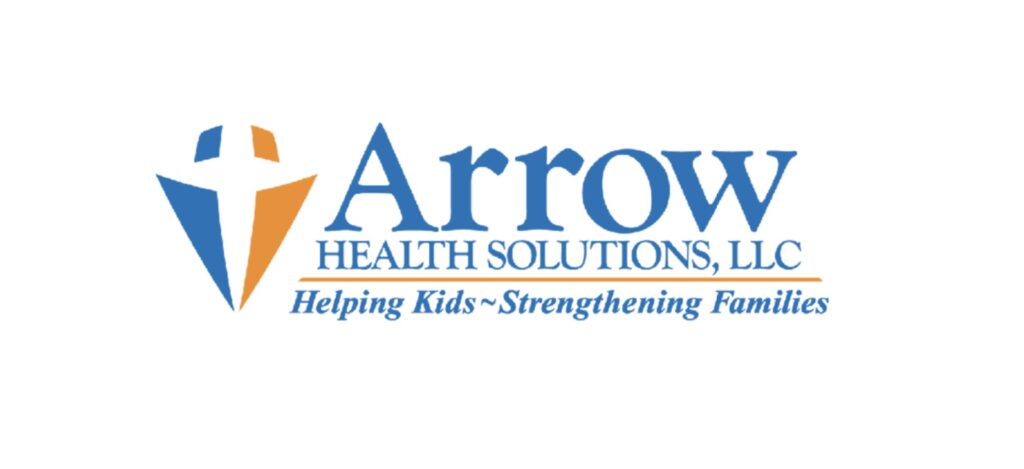
There is always something exciting going on in the foster care world! And fall is especially busy. If you’ve been wanting to get plugged in, now is the time to hop in!
Arrow is a child-placement agency for foster kids. In McLennan County alone, there are around 800 children in the foster system. When there are not enough homes for them, they are referred to as a CWOP (child without placement) and are often housed in CPS conference rooms or hotel rooms. Here at Arrow, we believe the best place for a child to grow up is in a family. We work each day to make sure that every foster child is placed in a loving and healthy home, one where they can grow and heal!
Does this sound like something you might want to know more about? Join us for our next Orientation, this October 26th at 6 pm. This low commitment Zoom class will tell you everything you need to know about foster care and Arrow.
Need more information first? Arrow Child and Family is pleased to announce we will be partnering with Nightlight Christian Adoptions for a monthly book club. Our kickoff meetup is at 1 pm on October 23rd at Glory Bell Coffee. We will be discussing the first half of Foster the Family.
Additionally, Waco’s Families and Foster Care Coalition will be hosting a multi-agency informational meeting on November 2nd. We would love to see you there!
It’s a great time to learn more about foster care! Contact Hope Middlebrook at [email protected] to learn about how to get involved. Whether you want to be a foster parent or get more information on how to donate to the kids in our community, we can all do something!
ABOUT
Arrow Child and Family Ministries is a child-placement agency committed to finding quality, loving homes for foster children. They were established in 1993 and have been a leader in the field ever since.
Be sure to tune in to the “Act Locally Waco” podcast! In their latest episode, they delve into the state of foster care in the city of Waco, shedding light on crucial insights and discussing ways you can make a positive impact. For a full and informative interview on Waco’s foster care system, featuring Hope Middlebrook from Arrow Child & Family Ministries, check out the podcast here! It’s an excellent resource to learn more about this important community initiative.
SOCIALS
Facebook:
https://www.facebook.com/arrowcfm https://www.facebook.com/groups/ArrowWaco
Instagram: https://www.instagram.com/arrowcfm/?hl=en Website: https://www.arrow.org/

WHO: The Salvation Army Waco Corps, Local Waco Walmart locations, Waco HEB Stores

WHAT: The 2023 back-to-school campaign encourages shoppers to purchase and donate school supplies and other requested items at the Salvation Army collection bins at Walmart on Franklin and in Hewitt from August 4th to August 6th. Additionally, all Waco HEB stores will be collecting Back to School donations for school supplies, which will be purchased for distribution by The Salvation Army. The aim is to provide new school supplies to 300-500 students in the McLennan County community, ensuring they have the necessary materials for the upcoming school year.
WHY: The collaboration between The Salvation Army and local communities, along with supporters like HEB and Walmart, helps meet the needs of people and serves over 23 million Americans annually through social services, aiding communities in overcoming poverty and economic hardships. This joint effort ensures children in Waco and surrounding cities have the school supplies they need for academic success.
WHEN: School supply collections at Walmart will take place on August 4th, 5th, and 6th, 2023, from 10 am to 6 pm. The HEB Back to School Event will be ongoing throughout August, including curbside purchases.
WHERE: Live event at Walmart on Sun Valley in Hewitt, scheduled for August 5, 2023, from 10 am to 6 pm. Interviews and photo opportunities can be arranged upon request before the event.
With temperatures soaring and the mercury reaching 100 degrees, The Salvation Army is taking measures to ensure the safety and well-being of those in need of respite. In response to the extreme heat conditions, The Salvation Army Cooling Station will be open and available to the public from noon until the temperatures lower each day.
The Cooling Station, located at 300 Webster in downtown Waco will serve as a refuge for individuals seeking relief from the scorching heat. The facility will operate during peak heat hours and provide a comfortable environment for residents to cool down and protect themselves from the potential risks associated with high temperatures.
Equipped with air conditioning and ample seating, the Cooling Station offers a safe space where residents can escape the heat and find relief. The facility will remain open during the heatwave, ensuring residents can access a cool and comfortable space when needed. In addition to an air-conditioned environment, The Salvation Army Cooling Station will provide access to clean drinking water. Hydration is crucial during extreme heat, and the station will have water available to help residents stay hydrated and prevent heat-related illnesses.
Major James Taylor urges those who need it to take advantage of the Cooling Station’s services during this period of extreme heat. “The well-being of our community is our top priority,” said Major Taylor. “We encourage anyone, especially the elderly and individuals with no other location to cool off, to use the Cooling Station and stay cool and hydrated during these weather conditions.”
Residents are advised to dress comfortably, wear loose-fitting clothing, and bring any necessary personal items they may require during their stay at the Cooling Station. It is also recommended to check on vulnerable neighbors and loved ones, particularly those more susceptible to heat-related illnesses.
Regular updates on the Cooling Station’s operations will be provided through official channels, including social media platforms and local news outlets.
Waterparks Open to the Public Mother’s Day Weekend
Moms are the heart of every household. They know what we need before we even ask. And they rarely ask for anything in return. To honor them, Hawaiian Falls Waco is inviting Moms to enjoy complimentary admission Mother’s Day weekend when the waterparks open to the public.

Photos by David Alvey
In addition to free admission, Moms will receive a special Hawaiian-themed gift (while supplies last) Saturday, May 13 and Sunday, May 14.
“We’re inviting mothers of all ages to come enjoy a day at the park to thank them for their selfless roles as cook, chauffeur, activity director, nurse, and countless other tasks they do for their families,” said Hawaiian Falls Marketing Director Ron Mckenzie. “We want Moms to enjoy a carefree day where others can wait on her. Float down the Lazy River and feel the stress melt away or recline in the shade and enjoy a cold drink while Dad races the kids down a slide. We want Mom to take away memories she’ll never forget.”
Hawaiian Falls will officially kick off the summer season with free admission to all active duty and retired military personnel with a valid Military ID Memorial Day Weekend, May 26 – May 29. The parks will be open daily beginning Friday, May 26.
Other special events planned throughout the summer include:
- Father’s Day weekend – Dads get in free June 17 – 19
- Champions Day – June 20 and July 22 Champions (individuals with special needs) and their families will have exclusive access to the park from 9 am -10 am. Champions tickets are FREE and family companion tickets are only $10 (limit 4).
- World’s Largest Swimming Lesson – June 22
- Independence Day weekend – Active duty and retired military personnel as well as first responders receive free admission.
- Aloha Fest – July 15 in Roanoke, July 22 in Mansfield, and July 29 in Waco.
- Family Fun Fridays throughout July with Ohana Games led by Hawaiian Falls Activity Director.
Season passholders can visit their home park to process their passes from 4 p.m. – 6 p.m. May 8 – 12 at the park’s front gate.
Hawaiian Falls Waterparks are located in Mansfield, Roanoke and Waco. More information about special events, operating hours, directions, tickets and season passes, are at hfalls.com.
By: Dr. Peaches Henry
I am relieved that the Llano County (Texas) commissioners kept their library system open and returned banned books to the library shelves. Yet, I am dismayed that Missouri’s House voted to cut all funding for libraries in its version of the state’s annual budget, because the American Civil Liberties Union, the Missouri Association of School Librarians, and the Missouri Library Association are suing the state over the censorship of some books from school libraries across the state. I do not intend to litigate the practice of banning books here. [To get my view on that, see my 1992 essay “The Struggle for Tolerance: Race and Censorship in Huckleberry Finn.”] Instead, during National Library Week (April 23-29), I want to celebrate the Waco McLennan County Library for the profound way it touches the lives of Wacoans.
Our library provides essential services to children, families, individuals, and the community at large. A truly remarkable place, the public library provides safe, accessible, one hundred percent free educational resources to everyone. It pools local resources like educational offerings, job training, and computer or internet access and puts them all in one place for use by the whole community. Whether you are a family looking for a fun story time, an immigrant looking for language help, a student working on a History Fair project, a person needing help on their taxes, or a homeless person looking for a place to cool off, you can find them all at the library—a place that has undergone transformation that makes it an altogether different place from the one previous generations enjoyed.
Indeed, the modern public library that serves Waco McLennan County is not your grandparents’ library. These days, there is more to the story when it comes to the library which provides services far beyond the traditional task of checking books in and out. Even that has been transformed. Patrons can access ebooks, emagazines, and audiobooks in the CloudLibrary and read them anywhere. They can also check out a mind-boggling range of “Special Items” which include blood pressure kits, sensory backpacks for specials needs children, disc golf kits, discovery boxes, and puppet kits. Special Items educational kits include flash cards, literacy kits for preschoolers, and STEAM kits for upper-elementary children. Among the most prized of the special items are the free family passes to local museums and sites including the Mayborn Museum, Cameron Park Zoo, and the Dr. Pepper Museum to name a few. The library’s Special Items collections offer free access to materials that many families cannot afford to purchase.
The library also boasts numerous, varied children’s programs aimed all ages. Everything from themed storytimes (money smart, STEAM, or super hero) to painting to a Minecraft and Roblox club to a look behind-the-scenes tour of the library to summer reading programs is available to children. As a member of the Library Commission, I was delighted to judge the library’s inaugural Edible Book Festival on April Fool’s Day.
In addition to catering to children, the library also offers essential support to adult Wacoans. It maintains partnerships with local entities which deliver needed services. The Heart of Texas Goodwill, for instance, holds computer skills and financial literary classes at the library. The Heart of Texas Workforce Solutions gives free one-on-one job skills training. The library hosts books clubs such as Books & Brew or the Mystery Book Club. It sponsors adult programs such as healthy crock pot cooking, an adult anime and manga club, and free tax preparation not to mention the work of the Genealogy Center.
The modern Waco McLennan County Library is a completely different place from the old Palestine Carnegie Library that I used to walk to as a child. Yet, in the most meaningful way, it remains the same iconic institution that I grew up with. The library is still the community hub that connects people to information, offers essential services and resources, brings people together, encourages lifelong learning, provides safe havens for children and adults, helps build healthy communities, and transports individuals around the world and to other worlds. Like libraries around the state and nation, our local library is an important public institution that we must support and protect now more than ever.
Dr. Peaches Henry is a member of the Waco McLennan County Library Advisory Commission.
